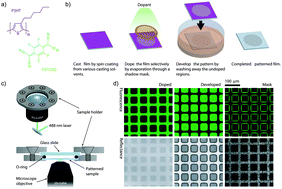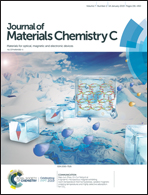Effect of processing conditions on additive DISC patterning of P3HT films†
Abstract
There is a critical need to develop a method to pattern semiconducting polymers for device applications on the sub-micrometer scale. Dopant induced solubility control (DISC) patterning is a recently published method for patterning semiconductor polymers that has demonstrated sub-micron resolution. DISC relies on the sequential addition of molecular dopants (here 2,3,5,6-tetrafluoro-7,7,8,8-tetracyanoquinodimethane (F4TCNQ)) to the conjugated polymer. In doped areas, the conjugated polymer is protected from dissolution while in undoped areas, the polymer dissolves into solution. Here we examine factors that affect the resolution of the developed pattern. Two factors are determined to be critical to pattern resolution, the initial crystallinity of the polymer, here poly(3-hexylthiophene) (P3HT), and the quality of the development solvent. We find that dopants diffuse more readily in highly crystalline films than in amorphous films of P3HT and that dopant diffusion reduces the fidelity of the resulting pattern. We also find that the choice of development solvent affects both the fidelity of the pattern and dopant distribution within the patterned polymer domains. Finally, we show that a dopant that diffuses more slowly than F4TCNQ in the P3HT film can be used to pattern the film with higher fidelity. These results together provide a road map for optimizing additive DISC patterning for any polymer/dopant pair.



 Please wait while we load your content...
Please wait while we load your content...